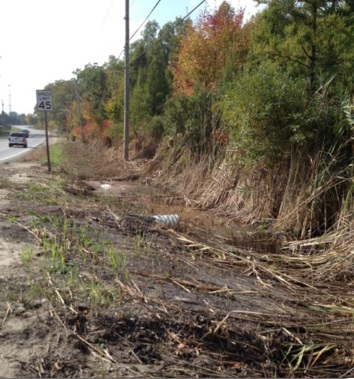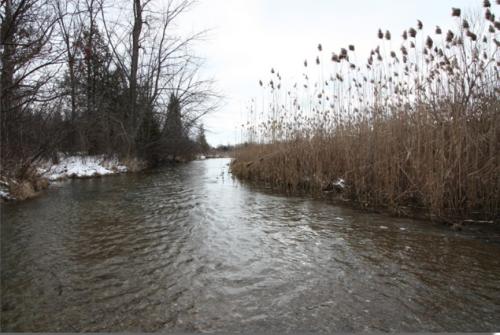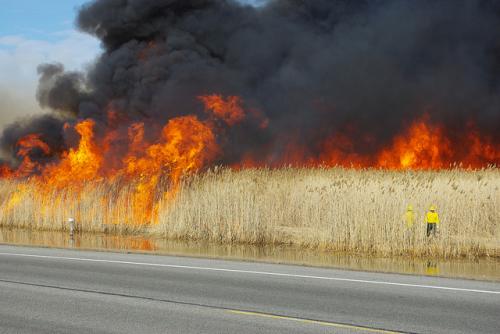Phragmites invasions harm riparian ecology: Part 2
Non-native invasive species increase liabilities of fires and flooding. Properties at risk of fire or flood experience reduced property value.
Michigan has many areas where fires or flooding are an ongoing concern. The introduction of Phragmites and similar non-native invasive plants can increase those risks. The unchecked growth of invasive plants may change how water drains, drying out wetlands and creating situations for local flooding. This can create the potential for fire hazards, especially in the spring where last year’s dead and dry growth is still standing.

Filling roadside ditches and blocking culverts. Photo credit: Emily Duthinh
Phragmites often grow so densely that they can change the local hydrology. Photo one shows Phragmites growing in a roadside drainage ditch. The Phragmites grew so thickly that they blocked the drainage culvert, causing rain to flood over the road. The county road commission mowed the roadside and cleared the drainage ditch and reopened the drain pipes. This maintenance is expensive, (plus it diverts road maintenance funds), and only solves the problem for a short time. The remaining Phragmites will regrow rapidly and block the culvert again.
Incidental to this road work is a contributing cause to the spread of Phragmites along roadways. Mowers are one of the major avenues of the spread of other non-native invasive plants including garlic mustard and the dog strangle-vine. Roadside mowers and earth moving equipment should have a cleaning protocol in place; cleaning their equipment between infected sites to remove seeds, plant parts, and rhizomes that spread the plants to new locations.

Phragmites growth narrowing a waterway. Photo credit: Emily Duthinh
Phragmites growing in Depot Park in Clarkston, MI and would have soon obstructed the stream connecting Deer Lake into Middle Lake reducing water flow capacity. Responding to the threat, the City of Clarkston treated the Phragmites effecting managing water flow and mitigating the risk of flooding the lowland, a city park, and several homes near Middle Lake. The wetlands are recovering and neighboring properties and their property values were preserved. Reduced property values reduce tax bases for communities. It is everyone’s interest for intervention when large areas become at risk. The idiom that “an ounce of prevention is worth a pound of cure” applies here.
Phragmites and similar invasive plants can grow so quickly, spreading many feet annually they can fill in wetlands in a few years. These invasive plants will also grow so densely that the thick mass of dry stalks and plant material covers the soil and speeds up eutrophication effectively drying out wetlands. Additionally, accumulated dry stalks from previous seasons can become a fire hazard.

Large areas of dry Phragmites stalks catch fire spreading into inaccessible wetland areas hampering fire control efforts. Sometimes, as part of an integrated pest management program, stands of Phragmites are intentionally set ablaze to clear out the old dry stuff to gain better access to the tender young shoots with an herbicide. Worst case scenarios are when they are set ablaze unintentionally through the same way any grass or brush fire starts. One such case was in March 2012; a grassfire whipped into a wildfire that spread to Phragmites growth area burning 160 acres near a populated area in Oakland County. This wildfire fire required closing I-75 and evacuating homes and businesses. The hollow stems of dry Phragmites reeds and some other invasive plants, like Japanese knotweed, act like tiny bellows, enabling dense monocultures of these invasive plants to burn exceptionally hot and fast. Multiple fire departments were required to put out that fire. Removing Phragmites before they become large single stands reduces these liabilities and helps to protect properties and wetland ecosystems.
For more information about invasive aquatic plants contact Beth Clawson, MSU Extension educator. To learn more about invasive organisms and invasive aquatic plants contact Michigan State University Extension Natural Resources educators who are working across Michigan to provide aquatic invasive species educational programming and assistance. You can contact an educator through MSU Extension’s “Find an Expert” search tool using the keywords “Natural Resources Water Quality.”



 Print
Print Email
Email


